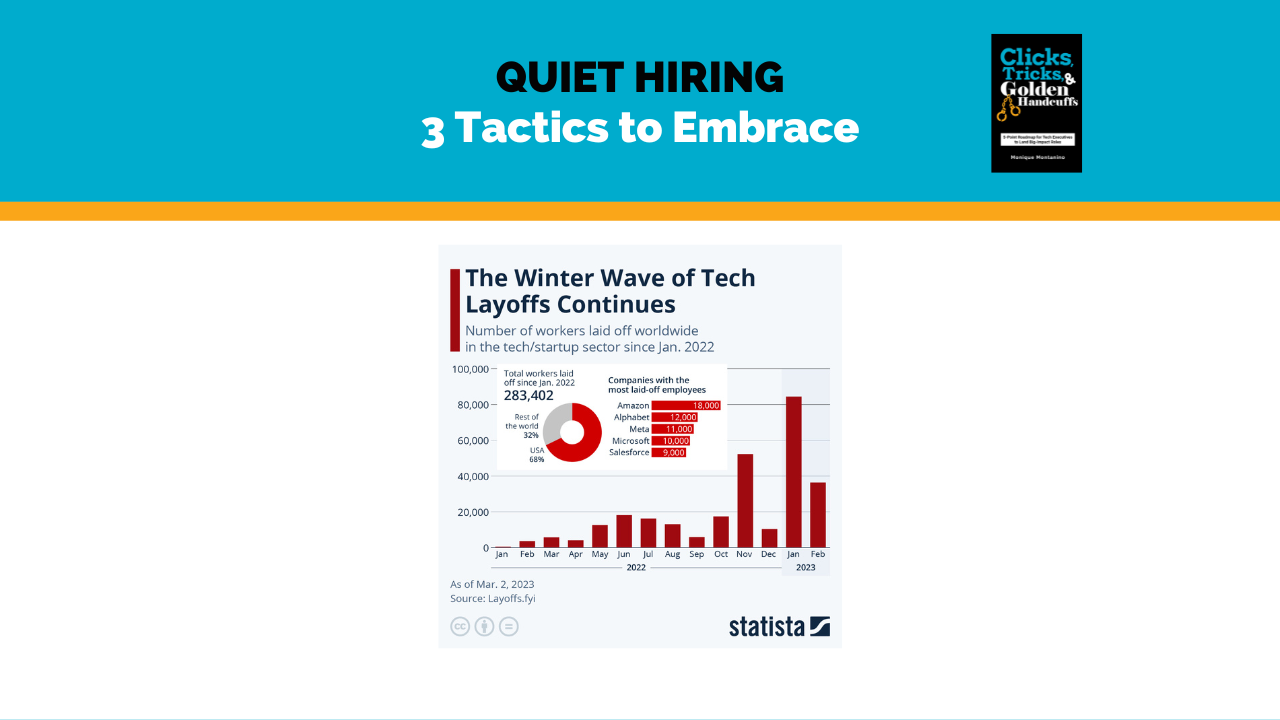Are you familiar with the term pink slip? The terminology dates back to the early 1900s when companies would insert a pink slip within an employee’s final paycheck envelope. It indicated the termination of their employment due to a firing or a layoff.
There’s been a ton of virtual pink slips being handed out lately in tech. Over the past year, company layoffs impacted almost 300,000 of you.
Layoffs occur when businesses focus on Wall Street’s missed earnings or cover increased costs in inflationary times. According to PayCor, labor costs can account for as much as 70% of total business costs; this includes employee wages, benefits, payroll, and other related taxes.
So, what happens to the current workload when your colleagues are gone?
Quiet hiring.
Gartner’s “HR Toolkit: Tackling 2023 Future of Work Trends” discusses how quiet hiring creates new avenues to secure in-demand talent. It’s not a new concept, simply a twist on terminology. But what does it mean for you as a retained employee or someone unemployed seeking your next role?
Gartner shares that “organizations find themselves with a unique challenge: keeping the in-demand talent they have — and finding the competitive talent they need — when staff budgets are contracting or staying flat. Fighting for new headcount will be challenging, so organizations will have to get creative.”
HR leaders focus on quiet hiring by filling talent gaps with the following alternatives:
- Rotate retained employees to other roles within the organization
- Expand the scope and responsibilities of current employees
- Hire part-time or contract labor
I’ve been through this situation endless times as a group business marketing manager at Sprint and CenturyLink (now Lumen). The work for my team remained the same, with a headcount reduction. We did enlarge the job responsibilities of all, including myself taking on additional tasks. Plus, we made use of outside contractors.
Today, I’ll focus on these three areas where you can drive the narrative: job rotation, expanded responsibilities, and becoming a consultant.
Job Rotation System
Transitioning employees between different roles is a win-win for the company and the employee.
- Employees gain from the perspective of learning, development, and motivation.
- Companies benefit by discovering hidden potential, retaining staff, increasing job performance, and broadening employees’ understanding of business operations.
While working at Sprint, I observed the C-suite hiring chief of staff, rotating every year between engineering, finance, human resources, marketing, operations, and sales. From a CEO succession plan, it made sense to onboard leaders to learn all aspects of the business.
I recall a sales VP with a finance background vs. decades of selling experience. For most of my corporate career, I worked in B2B marketing roles. For the last 6 years before early retirement, I transitioned into a role as a global accounts sales executive providing enterprise solutions for cloud, data, and IT consulting. Was it an easy move? Not initially. After years of enhancing my customer experience skills and developing cross-team collaboration with legal, finance, and sales engineering, extensive financial rewards followed.
If you’re an aspiring technology leader, there are plenty of functions to dive into, including, but not limited to, the following:
- Computer network architecture
- Computer systems analysis & administration
- Data engineering
- Data science
- Database administration
- Information & cyber security
- Information technology
- Network & systems administration
- Sales engineering
- Software development
- Web development
Based on client discussions, it’s annual performance evaluation time. During your career development review, I recommend obtaining input from your manager regarding a potential job rotation. You’ll both benefit.
Stretch Objectives
Returning to who takes on job roles after a pink slip moment, I’m venturing that your responsibilities increased as an existing team member.
In the Business Week bestselling book “Built to Last: Successful Habits of Visionary Companies,” the Stanford research authors discuss BHAGs—Big, Hairy, Audacious Goals. For employees, it means you see the corporate goals as challenging yet achievable. So, when a reduced headcount decimates your business unit, and you desire to continue employment there, it’s time to focus on your career passion, the company’s bottom line, and what you can be the best in the world.
This scenario leads me to stretch objectives. Having been in tech enterprise sales, I never considered my annual quota as easy-peasy.
If your goal is to stay at your company after the pink slip fall out, it would be advantageous to ask proactively for increased responsibility of your choice related to career succession. This idea might fly in the face of quiet quitting, but it’s a reality.
In a poll by Monster in January 2023 of 1,100 workers, 63% of the respondents viewed quiet hiring as an opportunity to learn new skills, and 19% were open to taking on a new role as long as it’s temporary.
For tech executive leaders, these are the activities I recommend you tee up to take on:
- Corporate spokesperson: Ask to be the tech person designated to speak at customer events, blog about company tech advances, and represent the organization at consulting events and tradeshows. One of the female powerhouses I mentor with data science experience was hired last year as a product management director at a software company because of her public speaking prowess. If this is outside your wheelhouse, it’s time to dive into the deep end and learn. Last year, I applied to speak at a dozen female tech events and practiced my storytelling. Take a course in public speaking, hire a speech coach, or use free AI speech apps like Yoodli.ai to enhance your delivery. If I can do it, I guarantee you can too.
- Lead integration: Here’s an opportunity to prove to your employer that you’re open to taking on more senior responsibilities. Overseeing an integration project allows you to interface and cross-collaborate with the executive team, PMO, solution experts, and internal or external client teams. In a leadership role, you can take on challenging projects that offer opportunities to excel in several application needs. You will assist in developing project implementation strategies and work plans while mentoring others.
Contracting & Consulting
While at CenturyLink, outsourcing was part of our portfolio of customer solutions. One of my colleagues managed one of the top-tier cloud computing accounts and purchased enough professional services that the sales teams overachieved their quota for three years. It was customary for the cloud company to have annual headcount reductions, so they managed the workload in part by hiring contractors.
If you’re unemployed, contracting or consulting could be an option since Amazon, Microsoft, and Google have hiring freezes in place. One reason to consider contracting is that it’s a way to walk through the door of your dream company. You’ll gain exposure to the corporate culture (maybe it could be more dreamy), processes, procedures, and management teams. The latter will eventually be hiring again; you’ve already made an introduction. After all, your connections can make a difference in hiring decisions.
The outsourcing companies for IT strategy for your consideration:
- Accenture
- BAE Systems North America
- Bain & Company
- Booz Allen Hamilton
- Boston Consulting Group
- Capgemini
- Cognizant
- Deloitte
- FiveRiver Technologies
- Fujitsu
- Gartner
- General Dynamics Information Technology
- IBM Global Services
- Infosys
- KPMG
- Lockheed Martin Corporation IT Consulting
- McKinsey & Company
- Northrup Grumman Corporation IT Consulting
- Protiviti
- PwC Advisory
- SAP Services
- Simform
- Slalom Consulting
- Tata Consultancy Services
- The NineHertz
- Trianz
- Wipro Technologies
How about you? Is now the time to use quiet hiring to your advantage if you’re unemployed or want to stay with your current employer?



